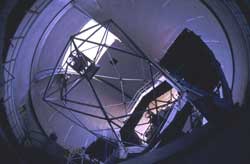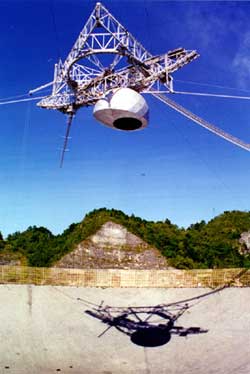The next big discovery in science will be the proof that alien
life exists - and it could come any day now...
by Heather Couper
A few weeks ago, I
put the finishing touches to one of the most visionary projects
I’ve ever been asked to present. The Essential Guide to
the 21st Century is the BBC World Service’s
flagship series for the start of the new Millennium. My brief was
to investigate where science will take us in the future – and
what are the big discoveries coming up.
In the course of a
whistlestop tour from the depths of the CERN particle accelerator
under the Alps to NASA’s Mars mission control overlooking Los
Angeles, scientists predicted some pretty mind-blowing ideas. Around
2020, we’ll be wearing mini-computers as fashion accessories,
with mini-robots surging around our bloodstream to scavenge viruses.
High overhead, astronauts on the International Space Station will
be attended by their own colourful, football-sized personal satellites.
And, in case A Brief History of Time wasn’t enough,
we’ll have to face the fact that the Universe isn’t made
of just three dimensions, but contains six or more tiny extra dimensions
all curled up on themselves.
But all the scientists
I interviewed were abuzz about the biggest story of all. They agreed
that this is the millennium in which we will discover intelligent
alien life – and make contact with it.

NASA The
infamous "microbes from Mars". Researchers are
still arguing whether these bug like shapes (magnified 100,000
times) are indeed fossilised bacteria.
|
Bizarre lifeforms
Until recently, we’ve
looked at life in a pretty conservative way. Wildlife films on TV
help to reinforce the notion that we – and our fellow-creatures
– live within a fairly narrow range of temperatures and environments,
and that, deep down, we all bear a strong family resemblance.
But this complacency
has all changed. In just the past three or four years, biologists
have discovered that life on Earth can exist in the most extreme
places, and in the most bizarre forms. Microbes have been found
down boreholes two kilometres deep. They live inside rocks scattered
across the freezing wastes of Antarctica. White crabs and giant
tubeworms inhabit scalding deep-sea vents that never see the rays
of the Sun.
These forms of life
may look more akin to ‘green slime’ than to our usual
idea of life on Earth. But they are still alive. When life gets
started, and wherever, it seems determined to hang on … for
dear life! So if life got started on our planet – and it did
so pretty quickly – then why not on some of our neighbour-worlds
in the Solar System?
Where are the Martians?
Mars has long been
a favourite with film directors, yielding untold numbers of B-movie
aliens. But many scientists are taking things a little more seriously.
Knowing that Mars is a smaller, colder version of Earth, they figure
it is a good place to start to search. Mars probably

NASA
The tiny Sojourner
rover on the Martian surface.
|
once had a thicker
atmosphere that could have supported embryonic life. And it almost
certainly had water on its surface in the past – perhaps even
oceans. Water is the essential lubricant of all living things: without
water, life as we know it cannot exist.
Both NASA and European
space scientists have planned a bold program of unmanned Mars exploration
that will sniff out life - if it exists – or even the remains
of long-extinct life-forms. The American missions are likely to
be delayed a couple of years, after the recent losses of NASA’s
Climate Orbiter and Polar Lander. This makes me less confident of
something I was loudly predicting last summer – that we would
see a manned landing on Mars in 2019, exactly 50 years after the
Apollo astronauts reached the Moon.
And casting my mind
back to last summer brings up vivid thoughts about life in the Universe.
My mission then was to cover an international conference on ‘bioastronomy.’
This regular Bioastronomy Conference is held every three years,
at some of the most beautiful and inspirational places on Earth
– the previous time it was Capri, and next time it will be
the Great Barrier Reef. The latest conference was held on the Big
Island of Hawaii.
Mars was high on the
agenda. Much of the debate concerned possible ‘Martian bugs’.
In 1996, strange structures – looking like fossilised wiggly
worms - had been discovered inside a meteorite which had been blasted
out of the planet and landed in Antarctica. The consensus last summer
– alas - was that the "bugs" were too small ever
to have been life.

NASA The
cracked, icy surface of Jupiter's water-moon, Europa.
|
Alien oceans
Instead, the scientists
were betting on a different ‘best-bet’ for finding life
in the Solar System. The smart money now is on Europa, a moon circling
the giant planet Jupiter. Europa is dazzling-white, and covered
in mysterious cracks. Images from the Galileo spaceprobe show that
its surface looks like the pack-ice you see when you fly over the
seas around Alaska or Greenland – and that’s just what
the bioastronomers believe it is.
The Galileo scientists
predict that, underneath the pack-ice, there’s a deep ocean
of water warmed by Jupiter’s continual gravitational pummelling.
Already, there are plans to send a probe to Europa early this century,
equipped with a robotic submarine. Will it find bugs? Or maybe something
more exotic like the giant tentacled creatures dreamt up by Arthur
C. Clarke in his novel 2010?
The Holy Grail of this
new millennium, however, is not to find bugs, but to locate intelligent
life. And optimism grows every day. Though we don’t expect
to find intelligent life on any of the Sun’s orbiting worlds,
there’s a fast-growing list of other places where the aliens
might live. Over the past five years, astronomers have been busy
finding planets around other stars. The total now stands
at 29 – with seven found in the last few weeks!

Keck Observatory The
Keck Telescope on Hawaii searches the sky for planets around
other stars.
|
Planets beyond
The technique astronomers
use to detect ‘extra-solar’ planets relies on the fact
that planets "tug" on their parent stars – like a
dog pulling on a leash. The jerk on the star is very small, but
by using sensitive instruments, scientists can measure the degree
of wobble and infer the masses and orbits of the encircling planets.
The most prolific team of planet-hunters is headed by Geoff Marcy
of San Francisco State University. Last year, Marcy’s team
discovered one star - Upsilon Andromedae – that has three planets
in tow, making it the first planetary system to be located beyond
our own.
So far, the technique
is only sensitive enough to pick up planets as massive as Jupiter
or greater. But if there are ‘Jupiters’ in existence,
there are almost certainly ‘Earths’ sprinkled amongst
them – it is just that our technology cannot yet winkle them
out. In the next few years, by using space-based telescopes, we
will undoubtedly be detecting worlds out there like our own.
If intelligent life
exists on any of these new worlds, how can we make contact? The
distances between the stars are too great for us, at our present
stage of development, to go in person. (Our fastest spaceprobes,
the Voyagers – which travel 20 times faster than a rifle bullet
- would take 40,000 years to reach the nearest stars.).

NAIC, Arecibo Observatory
The
giant Arecibo Radio Telescope waits for the call from ET...
|
ET: please phone
Earth! But
for at least part of their evolution, aliens will surely communicate
over long distances just as we do: by radio waves. They’re
cheap, fast - travelling at 300,000 km per second - and have
no worries about covering vast interstellar distances.
For the last 40 years,
a small number of astronomers have been listening-in for the elusive
signal from ET using huge radio telescopes – like Jodrell Bank,
or the vast dish at Arecibo, Puerto Rico. With clever electronic
detectors, we can now potentially tune into tens of millions of
‘extraterrestrial radio stations’ simultaneously. The
name of the game is SETI – the Search for Extraterrestrial
Intelligence.
But the call has never
come – despite some heart-stopping moments when interference
looked like the real thing. Some astronomers now are considering
the possibility that advanced civilisations might instead use laser
beams to make contact, and are searching the sky for suspicious
flashes of light. But how do you second-guess ET?
Friend or foe?
And some scientists
reckon that astronomers should not be conducting SETI at all. Contact
with aliens, they believe, would be downright dangerous for us.
Anthropologists have fears that an advanced intelligence –
if it had mastered interstellar travel – could come to Earth
and wipe out the human race, on the grounds that living creatures
are programmed to wipe out rivals. Other researchers believe that
the results of downloading the total sum of knowledge from an alien
intelligence would blow our puny brains.
But I strongly believe
that a dialogue with a more advanced intelligence would help us.
We’d learn from their mistakes – and benefit from their
advanced knowledge. Of course, none of this would stop us being
human, although I think it would change us in ways we cannot yet
know.
For those who urge
astronomers to call off the search in case we do make contact, I
can only say one thing: it’s too late. For the past 70 years,
the powerful signals generated by radio and TV transmitters have
been leaking away from our planet at the speed of light. They have
already reached hundreds of the nearest stars. If ‘they’
are out there, they already know that we are here.
|
